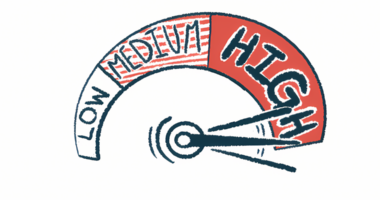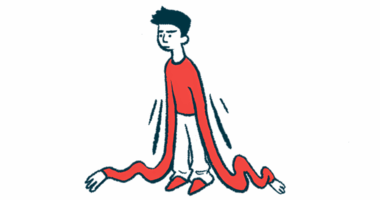Exploring the connection between myasthenia gravis and pain
Is pain a symptom of MG? It's complicated.

I can’t even begin to count the number of times I’ve seen some version of the following statement in online forums: “I hurt, but my doctors all tell me that pain isn’t a symptom of myasthenia gravis (MG). Does anyone else have pain?”
I see it in support groups, the MG News Forums, Facebook groups, Reddit conversations, Quora questions — everywhere.
If pain is so prevalent among people with MG, how can it not be considered a symptom of the disease? My fellow columnists have written about this topic time and again. Mark Harrington wrote about living with chronic pain, while Retha De Wet noted that her pain is just as real as her MG. And I’ve addressed how I’m learning to navigate pain and other comorbidities through self-care, massage, and elimination diets.
With all of these lived experiences chronicled, why is pain in MG still dismissed and misunderstood?
A Myasthenia Gravis News article titled “Does myasthenia gravis cause pain?” notes, “It is possible that pain arises secondarily to generalized muscle weakness.” From a patient perspective, what might that look like?
I will use myself in the following examples.
My 3 main pain points
I have chronic lower back and hip pain. My hip flexor and left leg are some of my weakest areas because of MG. When I overdo it and get fatigued, my left foot is always the first to start dragging, and I tend to overcompensate by thrusting my hip forward to help swing my leg forward. Does this trick sound familiar?
By compensating for the weakness in my legs and hips, other muscles have to work overtime. Overuse and overcompensation lead to the pain I feel in my hips and lower back.
My diaphragm and intercostal muscle are also weak. When I overexert myself during physical activity, I start feeling short of breath. If I’m unable to get the shortness of breath under control within 30 minutes, then I get an achy pain between my shoulder blades. My pulmonologist explained that it’s because those accessory muscles are taking up the slack to aid in breathing.
When I get especially tired, double vision sets in. It’s usually in the evening when I’m trying to read and relax. Sometimes I’m too stubborn and “refuse to let MG win,” so I keep reading two sets of lines. If I do that long enough, I’ll get a headache from the eye strain.
What can I say? After not being able to read because of cognitive decline for so many years, now that I’m able to, I’m a glutton for punishment and read every chance I get! But that’s another story for another day.
How I manage the pain
These are the three main types of pain I experience that I can directly associate with how MG affects my body. Now that I’ve identified them, the next question is how to manage this ugly stepsister of a symptom.
I’ve started strength training with my husband, who’s a personal trainer and coach. Together, we’re working on a program that can help me build strength without overtaxing and overexerting my body.
I’ve started putting self-care at the top of my priority list. I used to focus on doing all the things that I thought MG had taken from me. But one thing I’ve learned over the years is that my ability to tackle projects has more to do with my mindset than MG. I focus on getting enough sleep, fueling my body with nutritious food, getting massages, and spending time with friends.
Now that you know both you and your provider are right, what are you going to do about it?
Just a quick hint: Saying “I told you so” is not the answer.
Note: Myasthenia Gravis News is strictly a news and information website about the disease. It does not provide medical advice, diagnosis, or treatment. This content is not intended to be a substitute for professional medical advice, diagnosis, or treatment. Always seek the advice of your physician or other qualified health provider with any questions you may have regarding a medical condition. Never disregard professional medical advice or delay in seeking it because of something you have read on this website. The opinions expressed in this column are not those of Myasthenia Gravis News or its parent company, Bionews, and are intended to spark discussion about issues pertaining to myasthenia gravis.








Loes Eikens-Choufoer
I feel pain and cramps. Especially the cramps are very painfull and I use Inhibin for that. For my legs I use the Dr. Ho motion sicer. It helsps me to strengthen my muscles in the leggs The cramps are at my ribs and come from my back Inhibin normally is used for restless leggs, but it helps me to relax my muscles.. Happy New Year.
Lois Kantor
Exactly. The pain is real, and is often the worst problem. I', 79, diagnosed 5+ yrs ago with generalized MG. I have constant pain, and I know some of it is arthritis and other conditions, but I also know the thigh pain, chest pain, eye/head/neck pain are from the MG. It was the pain which finally got me dx'd, and although my neurologist says the pain is "probably" from the MG, I have no doubt. I read constantly, and use the computer for photography, etc. so my eyes/head and neck always hurt. I have a health background, am well-informed, and I KNOW the pain is from the MG. Sigh.
Susann Kircher
I agree. I am a physician who diagnosed myself in 2010. I have generalized MG but sero-negative so none of the new biologics are available to me. Once I am up my core muscles are so weak that just the mere act of standing with a rollader sends my back into constant progressive pain all day long. I’m talking about my thoracic and lumbar spine regions primarily but the pain in my neck and shoulders never stops often gets worse at night bc my neck muscles are so weak despite for 14 years trying ways to keep the neck muscles stable overnight. The pain is unreal and results in multiple knots in my neck and shoulders
Sadly I have tried massages, dry needling etc but my neurologist and the physical therapist I went to warned me it could make thinks worse. And it did.
Just trying to lift a small pan or pot sets off an entire slew of pain. I like to think of MG patients using their muscles for ADK’s as a weekend warrior who exercises and over exerts on the weekend then recovers from the pain all week. All that increased lactic acid build up increases pain among other things. Sadly, unlike weekend warriors we have no chance to recover because we use our muscles for ADL’s everyday so the pain continuously builds up. I used to work out everyday and ran marathons so I know what I am talking about when it comes to exercise. I have recently found a new caregiver who understands and does not dare let me pick up anything more than 12 ounces, which I have found is my limit and keeps me from bending over. I have 13 autoimmune diseases. But the most debilitating by far is MG